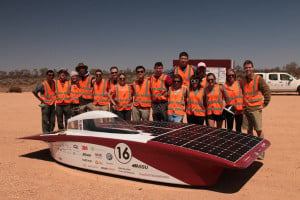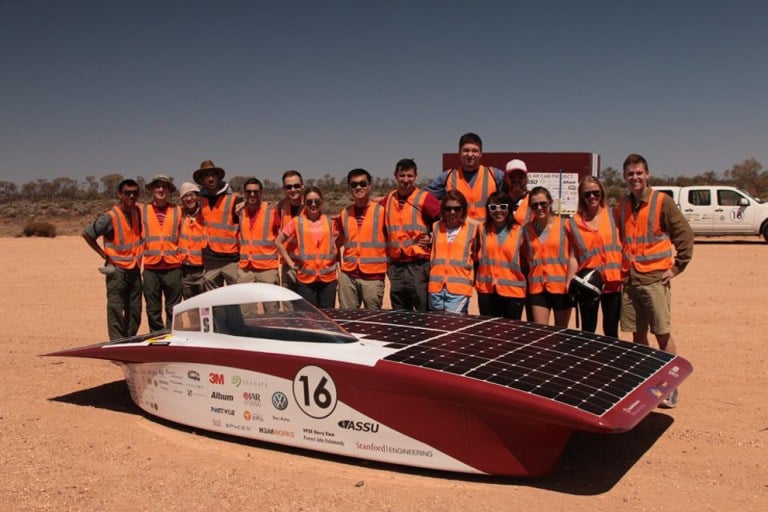
The Stanford Solar Car team recently came back from Adelaide, Australia, where they took part in the World Solar Challenge (WSC). The challenge consists of designing and building a car that uses only sunlight as fuel to race across the Australian Outback in the fastest time possible. Arctan, the name for the solar-powered car designed and built by members of Stanford’s Solar Car team, finished in sixth place.
Kelsey Josund ’16 and Gawan Fiore ’16, both current seniors studying computer science, ran Arctan’s telemetry system among other race components. Josund, the Team Lead, and Fiore, the Strategy Lead, sat down with The Daily to discuss their experience racing across the entire continent of Australia.
The Stanford Daily (TSD): What is the story behind the name of this year’s Stanford Solar Car, “Arctan”?
Kelsey Josund (KS): Every year we go through a big process of choosing the name. This year, it was in memory of a team member from the 2013 Stanford Solar Car team cycle. His name was Bryant Tan, and he died while traveling after graduating. He had been on the team and was a large contributing member during the 2013 cycle, so we felt that coming up with a name that could honor him would be great. That really had us considering Tangent, or Arctan, based on his last name, Tan. We decided that Arctan had better implications and also made a really cool logo.
TSD: Were you satisfied with the outcome of the race?
Gawan Fiore (GF): In terms of the race, yes, we were very satisfied with the outcome. Our approach to building cars this past cycle (2014-15) was that we weren’t necessarily trying to compete against the other teams, but we were more trying to compete against our previous performance in 2013. We set a standard, a 10 percent increase in our efficiency, and to essentially improve by 10 percent. We did achieve that and in that regard, we are satisfied. Despite running into issues with testing, we had no problems during the race. We ran a flawless race, start to finish, and never had to stop. We never had to pull over on the side of the road to fix anything. That was kind of a validation and a testament to one of our mottos, which is focusing on putting all of the components and pieces of a car and the car itself that we’ve created through all the possible tests we could come up with. We wanted to make sure that the car really works and that it is a quality piece of engineering. In that sense, it was a big success.
KS: We came in sixth place, which is a lower place than in the 2013 race, but we were closer in time to the winner in 2016 than we were in 2013. This just meant that everyone else was doing better as well.
TSD: What was the most exciting part of the season? What was the most stressful part of the season?
GF: The most fun part of the event was being in Australia with close to 1,200 to 1,400 people, students from around the world who were doing exactly the same weird project. I loved being able to meet all of them, and everyone was coming together for this grand challenge, this five-day trek across a continent. Even though we couldn’t talk to all of the teams because not all of the teams spoke English, just being able to even communicate with a handful and share experiences — that was by far the most fun part. If it hadn’t been for the other teams, it wouldn’t have been the same experience and wouldn’t have been nearly as exciting. The people made it the event that it was.
KS: Gawan and I, during the race, were both running the telemetry system, which basically meant that we were sitting and staring at a computer screen throughout the entire race. We were moderating all of the systems of the car and giving that data to the strategists who use it to figure out how fast the car should be going and what all the numbers mean. What was most stressful was knowing half of what was going on. I knew all of the numbers, but I wasn’t part of the decision-making process about how fast to go at any one time. It was stressful to have just enough information but not actually be calling the shots.
TSD: What was an unexpected part of the event that stood out to you during the race?
KS: My favorite moments were the many nights we spent camping out in the outback, in the middle of nowhere just on the side of the road. We were so far from lights so we could see the stars, which were incredible. I had heard about seeing the stars without a city nearby before, but actually seeing it is really something else.
GF: For me, there was one night where we were camping a little bit north of a town called Coober Pedy. We pulled over to a somewhat grassy but mostly dirt area, and we set up camp. As the sun set, we started using our headlamps to see and to go about cooking our dinner and setting up tents. We started to see that the grass and the ground around us was kind of sparkling, and it looked like there were diamonds in the grass that were reflecting light back at you. It was quite beautiful, but on further investigation we discovered that the sparkles in the grass were actually eyes of thousands of spiders. The spiders were everywhere. Fortunately, they were wolf spiders, which are perfectly harmless.
TSD: What would you tell someone who is considering joining Stanford Solar Car about your experience?
KS: Solar Car is unlike anything else you can do at Stanford. It is so incredibly student directed; it’s professional-level engineering and business undertaking, but we as undergrads make almost all the decisions. It is an opportunity to learn a ridiculous amount and in a lot more fun of a way than I have in any of my classes. I’ve certainly learned more in Solar Car than in most of my classes. It’s really fun. It gives you a chance to get to know people at a whole other level — before and during the race. All of our test drives, and building a car — we’ve lived and worked with this team for six months. We were all either living in a big house together or staying in a hostel or camping together. When you are working all day, you really get to know people. It’s a really cool opportunity, and you really can’t do this at any other time of your life.
GF: Going out to Australia for the race was a life-changing experience, as cliché as it sounds. It really does give you a different perspective on the type of things you can do out in the professional world [that] you don’t quite get even if you’re interning. You don’t get the sense of ownership that you do through working on this project with other students. The team is only 40 people so it’s not a large group, but we produce a pretty significant project. In addition to the opportunities, it can be a little bit intimidating when you first join and are trying to learn from engineers who have all this experience under their belt. I certainly felt that way when I joined, but as long as you want to learn and as long as you stick around, you’ll start learning so much more than you can possibly imagine. A lot sooner than you expect, you’re going to end up being one of those people who know so much about all sorts of different types of engineering. If you put in a lot, you get out an incredible amount.
Contact Friend Chaikulngamdee at friendc ‘at’ stanford.edu.
